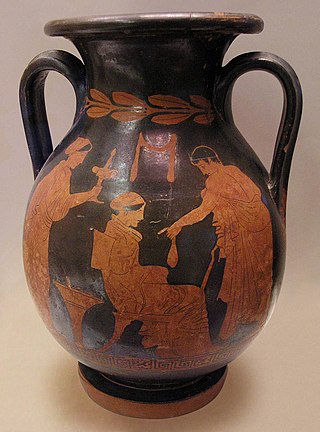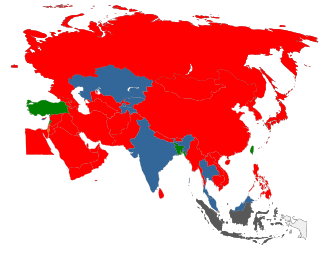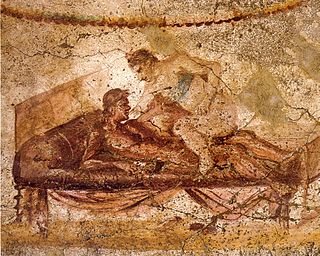This article needs additional citations for verification .(January 2024) |
Sing-song girls, also known as flower girls, is an English-language term for the high class prostitutes in China during the 19th century AD.
This article needs additional citations for verification .(January 2024) |
Sing-song girls, also known as flower girls, is an English-language term for the high class prostitutes in China during the 19th century AD.
In ancient China, concubinage was legal. In Chinese custom, males carry the family name and the family's heritage after marriage. To ensure male heirs were produced, it was a common practice for an upper-class married male to have one or more concubines, provided he could support them.The custom could be invoked without the wife's consent: the husband's actions were protected by law. Concubines would co-exist in the family along with wives and children. A man might choose a courtesan or Gējì to be his concubine. Many of these courtesans would sing songs to attract potential husbands, hoping to become secondary wives. [1]
With the development of the times, in the late Qing Dynasty of China, the "Chinese Geji culture" declined and began to be replaced by high-class prostitutes.Sing-song girl literally means a singing girl, but this is not the case. At that time, high class prostitutes in China called themselves "Xiansheng" or "Xisang" in order to raise prices."Xiansheng(先生)" in Wu dialect is pronounced like "Xisang(西桑)",the British and Americans in Shanghai mistakenly thought it meant "singsong".Because these prostitutes also sing at the banquet,the name "sing song girl" appears, which is not the translation of "singing girl". "Singing girl(歌女)" was a new term from the late 1920s to the 1930s, after there were dancing girls(舞女).The real meaning of Sing-song girl is the translated name for high-class prostitutes from the late Qing Dynasty to 1949 in China. [2]
Western observers in China during the nineteenth century witnessed these women singing but had no idea what to call them. Thus the term "Sing-Song Girls" came about. [1]
According to the 1892 fictional masterpiece by Han Bangqing called Sing-Song Girls of Shanghai (later adapted into the 1998 film Flowers of Shanghai ), people in Shanghai called the women who prostitution in “Changsan brothel or Changsan apartment” 先生 (pinyin :xiānshēng) in the Wu language. The term was pronounced like "sing-song" in English and the young prostitute always sang to entertain the customers; thus, Westerners called them Sing-Song girls. The word sian sang in this case is a polite term.
The literal meaning of "Sing Song Girl" in English may seem to mean a singing girl or a literal translation of a singing girl, but in reality, it is not. According to Zhang Ailing, "Sing song girl" is a term derived from the Wu language, which also refers to high-end prostitutes as "sir". "sir" can be a polite term for anyone, regardless of gender. In Wu's language, 'sir' is pronounced as' Xisang ', but the English and American people in Shanghai mistakenly thought it was' sing song', and they were required to sing at banquets. Therefore, 'sing song girl' is named after it, not the translated name of a singer girl. Singing girl is a new term from the late 1920s to the 1930s, and it is also after dancing girl.
Among sing-song girls were actually several subclasses of high-end prostitutes divided by the quality of skill. Over time, these would evolve, beginning with one class, developing into four, and consolidating down to two. It was not until the founding of New China that the profession of prostitutes was abolished. [3]
Below these, fell those whose services were purely sexual. The women serving in the lowest tiers of the sex trade were often there as a result of being sold, mortgaged, kidnapped, or otherwise forced into the industry. (These do not address the women in other industries, such as masseuses and taxi dancers, who part-time sold sexual services.)
Even the highest class Changsan could not escape the ignominy of the sex trade. Traditional views held that once married, a woman had no need to impress anyone. In conjunction with Confucian ideals of the virtues of modesty, this led to a standard of dress aimed to hide the form of the body within. However, sing-song girls, being unburdened by such virtues. An example of this can be seen in the cheongsam, which not only became more form fitting, but also became sleeveless with a long slit running up each side. [7]
They often decorated their parlors with expensive decor and modern amenities, making them culturally progressive to the point where there are documented cases of women sneaking into the entertainment houses to catch a glimpse of what the latest decorations and fashions were. [8]
Some prostitutes began to use portraits of themselves as a way to attract business, early business cards. [9] [8]
After the Chinese Communist Party seized power in 1949, it gradually carried out earth-shaking transformation of Chinese society, including the abolition of the prostitution system that had existed for thousands of years in a relatively short period of time. Hundreds of thousands of prostitutes and related industry personnel such as brothel owners, etc. across the country have been dealt with in various ways.Prostitutes receive human rights assistance and medical attention, and brothel owners face legal penalties.
During the Republic of China, there were a huge number of prostitutes in China.Prostitutes in old China generally suffered from sexually transmitted diseases. Among the prostitutes in Beijing, 96.6% of them suffered from syphilis, gonorrhea, and fourth sexually transmitted diseases. In Shanghai, 89.9% of the first batch of prostitutes admitted had sexually transmitted diseases. Of the more than 5,000 prostitutes admitted from 1951 to 1957, 2,267, accounting for 41.98%, were found to have syphilis. In Beijing, Shanghai and Nanjing, large sums of money were allocated to purchase penicillin, which could not be produced in China at the time, to treat sexually transmitted diseases for prostitutes. Beijing earmarked 100 million yuan (old currency) for this purpose.After the founding of the People's Republic of China, prostitutes could be taken home by their families, get married, or have jobs arranged by the government. [10]

Sexual slavery and sexual exploitation is an attachment of any ownership right over one or more people with the intent of coercing or otherwise forcing them to engage in sexual activities. This includes forced labor that results in sexual activity, forced marriage and sex trafficking, such as the sexual trafficking of children.

A brothel, bordello, ranch, or whorehouse is a place where people engage in sexual activity with prostitutes. However, for legal or cultural reasons, establishments often describe themselves as massage parlors, bars, strip clubs, body rub parlours, studios, or by some other description. Sex work in a brothel is considered safer than street prostitution.

Yoshiwara (吉原) was a famous yūkaku in Edo, present-day Tokyo, Japan. Established in 1617, Yoshiwara was one of three licensed and well-known red-light districts created during the early 17th century by the Tokugawa shogunate, alongside Shimabara in Kyoto in 1640 and Shinmachi in Osaka.

Prostitution in Japan has existed throughout the country's history. While the Prostitution Prevention Law of 1956 states that "No person may either do prostitution or become the customer of it", loopholes, liberal interpretations and a loose enforcement of the law have allowed the Japanese sex industry to prosper and earn an estimated 2.3 trillion yen per year.

Flowers of Shanghai is a 1998 Taiwanese drama film directed by Hou Hsiao-hsien. It is based on the novel The Sing-song Girls of Shanghai (1892) by Han Bangqing, which was originally written in the Wu language (吳語) and translated into Mandarin Chinese by Eileen Chang. The film stars Tony Leung as a wealthy patron and Michiko Hada, Annie Shizuka Inoh, Shuan Fang, Jack Kao, Carina Lau, Rebecca Pan, Michelle Reis and Vicky Wei as "flower girls" in four high-end Shanghai brothels. It was voted the third best film of the 1990s in the Village Voice Film Poll conducted in 1999. The film was selected as the Taiwanese entry for the Best Foreign Language Film at the 71st Academy Awards.
Prostitution is illegal in Russia. The punishment for engagement in prostitution is a fine from 1500 up to 2000 rubles. Moreover, organizing prostitution is punishable by a prison term. Prostitution remains a very serious social issue in Russia.

Oiran is a collective term for the highest-ranking courtesans in Japanese history, who were considered to be above common prostitutes for their more refined entertainment skills and training in the traditional arts. Divided into a number of ranks within this category, the highest rank of oiran were the tayū, who were considered to be set apart from other oiran due to their intensive training in the traditional arts and the fact that they lived and worked in Kyoto, the political capital of Japan, which remained the cultural heart of the country when the seat of political power moved to Tokyo. Though oiran by definition also engaged in prostitution, higher-ranking oiran had a degree of choice in which customers they took; tayū, in contrast, did not engage in sex work at all.

After taking power in 1949, the Chinese Communist Party (CCP) embarked upon a series of campaigns with the aim of eradicating prostitution from mainland China by the early 1960s. Since the loosening of government controls over society in the early 1980s, prostitution in mainland China not only has become more visible, but can now be found throughout both urban and rural areas. In spite of government efforts, prostitution has now developed to the extent that it comprises an industry, one that involves a great number of people and produces a considerable economic output. Prostitution has also become associated with a number of issues, including organized crime, government corruption, hypocrisy, as well as sexually transmitted diseases. Notably, a CCP official who was a major provincial campaigner against corruption was removed from his post and expelled from the party after he was caught in a hotel room with a prostitute in 2007.
Prostitution in Hong Kong is itself legal, but organised prostitution is illegal, as there are laws against keeping a vice establishment, causing or procuring another to be a prostitute, living on the prostitution of others, or public solicitation.

Prostitution was a common aspect of ancient Greece. In the more important cities, and particularly the many ports, it employed a significant number of people and represented a notable part of economic activity. It was far from being clandestine; cities did not condemn brothels, but rather only instituted regulations on them.

A Gējì or Geji is a female professional performer of song and dance in ancient China. The modern term "Yiji (艺妓)" is not used in ancient Chinese sources. The modern expression "Yiji (艺妓)" in Chinese may have been first seen in the novel "The Ancient House" by Wang Xiyan.The modern expression "Yiji(藝妓)" in Chinese may also have appeared earlier in Taiwan's Alias for Yidan(藝旦) during the Japanese occupation.

Prostitution in Pakistan is a taboo culture of sex-trade that exists as an open secret but illegal. Prostitution is largely based in organisational setups like brothels or furthered by individual call girls.

The sex industry consists of businesses that either directly or indirectly provide sex-related products and services or adult entertainment. The industry includes activities involving direct provision of sex-related services, such as prostitution, strip clubs, host and hostess clubs and sex-related pastimes, such as pornography, sex-oriented men's magazines, women's magazines, sex movies, sex toys and fetish or BDSM paraphernalia. Sex channels for television and pre-paid sex movies for video on demand, are part of the sex industry, as are adult movie theaters, sex shops, peep shows, and strip clubs. The sex industry employs millions of people worldwide, mainly women. These range from the sex worker, also called adult service provider (ASP), who provides sexual services, to a multitude of support personnel.

Prostitution in ancient Rome was legal and licensed. Men of any social status were free to engage prostitutes of either sex without incurring moral disapproval, as long as they demonstrated self-control and moderation in the frequency and enjoyment of sex. Brothels were part of the culture of ancient Rome, as popular places of entertainment for Roman men.

Prostitution has been practiced throughout ancient and modern cultures. Prostitution has been described as "the world's oldest profession"..
Prostitution in Eritrea is legal and regulated. Official figures state there are around 2,000 prostitutes in the country, who are not allowed to operate near schools, hospitals, and churches. According to the 2009 Human Rights Reports, security forces occasionally follow women engaged in prostitution and arrest those who had spent the night with a foreigner. Some women enter prostitution due to poverty. Prostitutes are known locally as "shermuta" in Arabic, or "mnzerma" and "me'amn" in Tigrinya.
The Sing-song Girls of Shanghai, also translated as Shanghai Flowers or Biographies of Flowers by the Seashore, is an 1892 novel by Han Bangqing.
Prostitution in Impressionist painting was a common subject in the art of the period. Prostitution was a very widespread phenomenon in nineteenth-century Paris and although an accepted practice among the nineteenth century bourgeoisie, it was nevertheless a topic that remained largely taboo in polite society. As a result, Impressionist works depicting the prostitute often became the subject of scandal, and particularly venomous criticism. Some works showed her with considerable sympathy, while others attempted to impart an agency to her; likewise some work showed high-class courtesans, and others prostitutes awaiting clients on the streets. In addition to the sexual revulsion/attraction the figure of the prostitute stirred, she functioned as a sign of modernity, a clear sign of the entanglement of sex, class, power and money.

Qiyān were a social class of women, trained as entertainers, which existed in the pre-modern Islamic world. The term has been used for women who were both free, including some of whom came from nobility, and non-free women. It has been suggested that "the geisha of Japan are perhaps the most comparable form of socially institutionalized female companionship and entertainment for male patrons, although, of course, the differences are also myriad".
Sex Work in Shanghai within the 19th and 20th Century lead China to become known as the "brothel of Asia." With Shanghai's rapid expansion of factories, migration, and refugees, gangs and prostitution quickly spread through the city. This resulted in the exploitation of young women and children, sex trafficking, and imperialist policies. In addition, social turmoil within the mid 19th century such as the Taiping civil war shifted the economic and political state of Shanghai. This furthered the rise of prostitution to rapidly spread. A clear hierarchy within the sex industry soon began to develop creating a large class distinction between the sex workers. This forced many young woman to work tireless to reach ends meet while others were able to live lives of luxury.